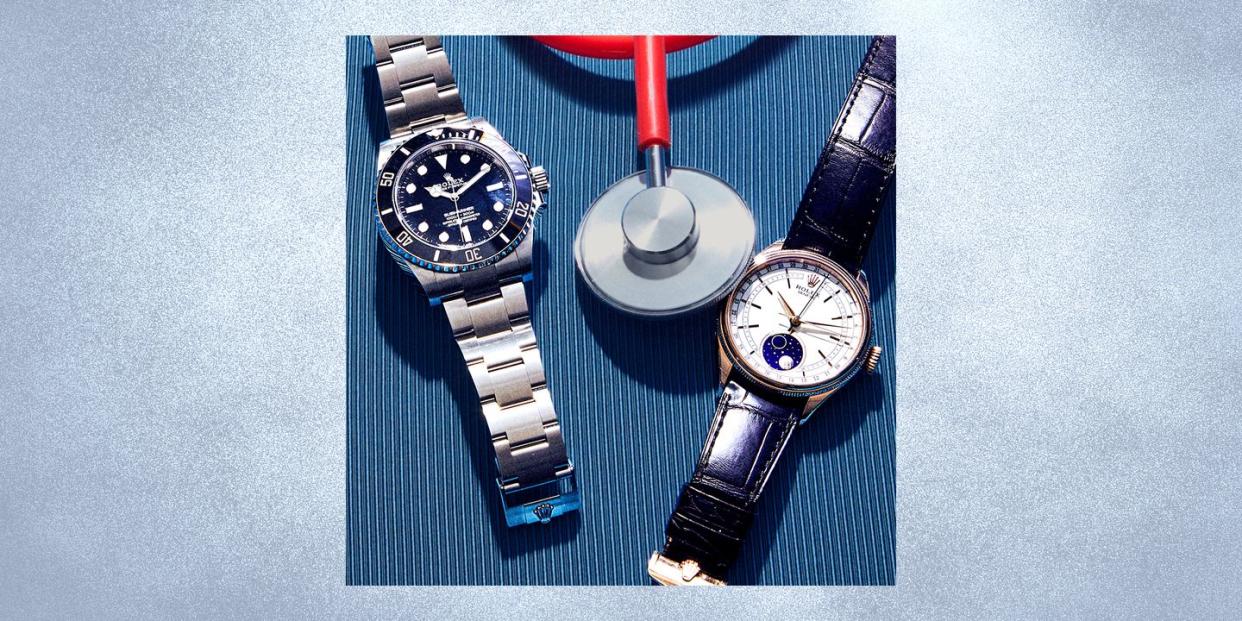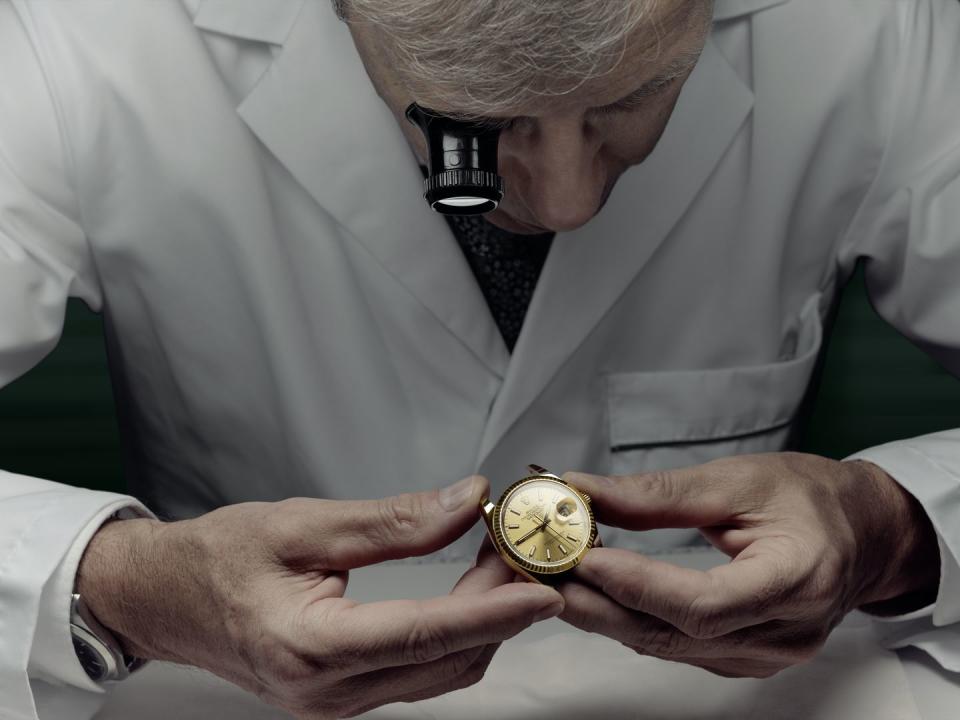Where Your Timepiece Goes When It Needs a Time-Out

Rolex owners rarely give watch repair a second thought. We imagine that tuneups, when needed, happen somewhere that resembles a combination of the tree where the Keebler elves bake cookies and the munitions lab where Q cooks up new gadgets for 007. Over the years I had heard whispers of a “watch spa,” the horological equivalent of knowing about the o-ff-the-menu burger at Raoul’s. But it was the stuff of myth, like El Dorado.
Then, on a recent gray day, I found myself driving through Lancaster County, Pennsylvania where the rolling farmland looks ripped from Andrew Wyeth. As I turned into Lititz, which bills itself as “America’s Coolest Small Town,” an unmarked 40,000-square-foot facility came into view.
It had the vibe of a Silicon Valley tech campus, except it was composed of two postmodern stone barns and a grain silo, the three joined by the late “New York Five” architectural great Michael Graves. The only hint that there might be a king’s ransom worth of watches inside was my GPS reading: “Rolex Watch USA.”
I had arrived at a slice of Switzerland in the Susquehanna River Valley, the fabled watch hospital where Rolexes from all around the country come to be rehabilitated and readied for the next generation. On any given day scores of them are getting worked over, stretched, prodded, and tweaked, with more care than you’d find in a boot camp at Canyon Ranch (though here the average stay is less than three weeks), because some of the timepieces need a timeout.
“We once received a watch after a wife was so angry with her husband that she dropped his Rolex into the garbage disposal,” one of the managers of the facility told me during a rare tour extended exclusively to T&C. When the watch arrived here, the incoming order form read “Customer says it slipped off her wrist and fell under the car while backing up.”

Only genuine, non-altered Rolexes can score entry into one of the elite service centers, which can be found all over the country—but this spot is Valhalla. Ten years into the life of a Rolex it may start to show hints that it needs a refresh, losing a second or two every day. Sometimes customers wait until their watch literally stops; others send theirs for more regular servicing the way people change the oil in their cars.
The last time I had sent my Rolex in for service was in the 1990s, and as I made the rounds meeting various technicians, people would ask to see my late-’60s Submariner and then react as if I were handing them a late-’80s Chet Baker o my wrist. Everyone was too polite to say of this faded icon, “Jeez, you really ought to get that looked at.” The most anyone would say is, “Do you still wear that in the ocean?”
There are roughly 125 people who revitalize watches here; specialized technicians, who usually spend three months in a training program here followed by nine months of working closely with a supervisor, and watchmakers, who receive about two years of training, including, for many, time at Rolex HQ in Switzerland. (In 2001 Rolex opened a Technicum at the Lititz site to train the next generation of watchmakers.)
But regardless of who is doing it, the work requires both a high level of dexterity and a special temperament. The OCD side of my personality was envious of a professional life in which every day is spent intently focused on a canvas that is no larger than a postage stamp.
Some of the most detailed and delicate work takes place at the stations where the movement is taken apart and refurbished. In a nutshell, the movement is really the vital organ of a watch. The rotors, levers, and jewels are so tiny that the techs here use 25X magnifying loupes and work with tweezers. When a watch comes in for service, the main spring (the heart of a watch) is always replaced. If any of the gears have dull teeth, they’re replaced too. After key parts have been replaced, the movement is cleaned, lubricated, and reassembled. A watchmaker manning the quality control station will look over and test the movement, like a teacher with a red pencil; he may send it back if it doesn’t pass muster.
Every so often a celebrity watch passes through Lititz, and a director told me management sometimes tries to match the piece to the technician who will appreciate it the most, so that a golfer might work on Arnold Palmer’s watch, a downhill skier on Lindsey Vonn’s, or a Billy Joel fan on the singer’s two-tone Rolex Datejust. I couldn’t help picturing a watchmaker humming “Uptown Girl.”

The operating theater at this sanatorium is the case department. It is here that the crowns, bracelets, and casings are refurbished, in a sort of glorified body shop, one that is immaculate enough that you could eat sushi off the counters. The day I visited, a particularly banged-up Yacht Master was undergoing some plastic surgery. To remedy the years of misadventures at sea, a tech in a green lab coat and safety goggles was working the case against a felt-covered wheel covered with cutting paste. As the case was rolled from side to side, the nicks were gradually ground away.
Once the scars are gone, it’s on to a different wheel covered with so microfiber sheets that bring the dial back to its original luster. And on to a third wheel for a final polish. But not every customer wants his dial restored. When a mountaineer’s Explorer came in for repair, a director realized that the watch belonged to a well-known alpinist who had summited Mount Everest. So he called the climber to ask whether he might want to leave the casing as is—after all, it had been a witness to history.
“I like the scarring on my casing, too,” I yell over the din of the sanding machines. Again my claim is met with a look that says, “You really need to take better care of that thing.”
With refinishing completed, the watch heads to a sort of decompression chamber fitted with high-tech gizmos that test how it will operate underwater and under pressure.
The day I was there a Sea Dweller, a watch that is waterproof to a depth of 4,000 feet, was put through the ringer inside a machine that looks as if it could be Tony Stark’s rice cooker. Once cleared, the watch receives another round of quality control, and then it’s reunited with its bracelet and packaged up for its return to its owner.
As I get back in the car to head home, I feel a bit guilty that I’ve brought my watch to see all the different treatments available, yet I did not leave him for some pampering. How many other relationships in my life have run without a hitch for more than 20 years? The look I get from this inanimate object is reminiscent of the one I get from our 11-year-old every time one of her friends gets a puppy.
“Soon,” I find myself whispering to no one in particular as I turn onto the Pennsylvania Turnpike. “I promise.”
This story appears in the Summer 2021 issue of Town & Country. SUBSCRIBE NOW
You Might Also Like


